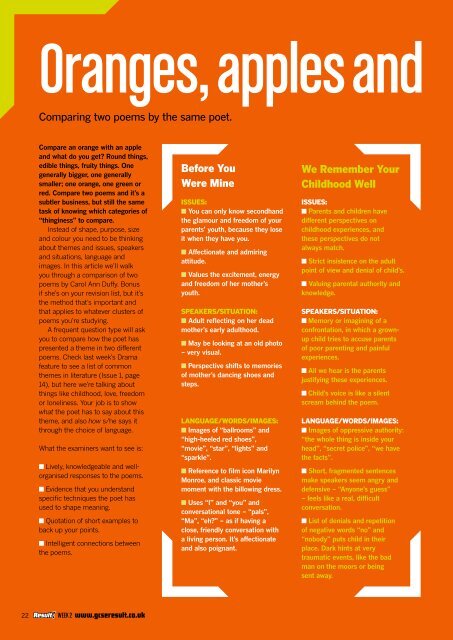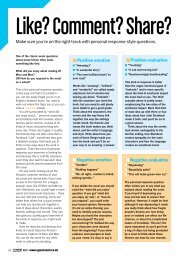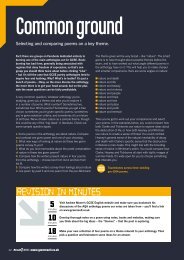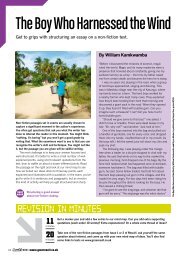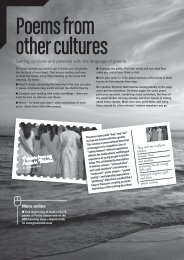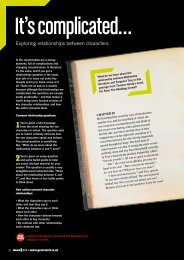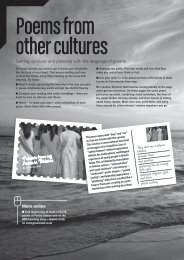Comparing two poems by the same poet. Before You Were Mine We ...
Comparing two poems by the same poet. Before You Were Mine We ...
Comparing two poems by the same poet. Before You Were Mine We ...
Create successful ePaper yourself
Turn your PDF publications into a flip-book with our unique Google optimized e-Paper software.
Oranges, apples and<br />
<strong>Comparing</strong> <strong>two</strong> <strong>poems</strong> <strong>by</strong> <strong>the</strong> <strong>same</strong> <strong>poet</strong>.<br />
Compare an orange with an apple<br />
and what do you get Round things,<br />
edible things, fruity things. One<br />
generally bigger, one generally<br />
smaller; one orange, one green or<br />
red. Compare <strong>two</strong> <strong>poems</strong> and it’s a<br />
subtler business, but still <strong>the</strong> <strong>same</strong><br />
task of knowing which categories of<br />
“thinginess” to compare.<br />
Instead of shape, purpose, size<br />
and colour you need to be thinking<br />
about <strong>the</strong>mes and issues, speakers<br />
and situations, language and<br />
images. In this article we’ll walk<br />
you through a comparison of <strong>two</strong><br />
<strong>poems</strong> <strong>by</strong> Carol Ann Duffy. Bonus<br />
if she’s on your revision list, but it’s<br />
<strong>the</strong> method that’s important and<br />
that applies to whatever clusters of<br />
<strong>poems</strong> you’re studying.<br />
A frequent question type will ask<br />
you to compare how <strong>the</strong> <strong>poet</strong> has<br />
presented a <strong>the</strong>me in <strong>two</strong> different<br />
<strong>poems</strong>. Check last week’s Drama<br />
feature to see a list of common<br />
<strong>the</strong>mes in literature (Issue 1, page<br />
14), but here we’re talking about<br />
things like childhood, love, freedom<br />
or loneliness. <strong>You</strong>r job is to show<br />
what <strong>the</strong> <strong>poet</strong> has to say about this<br />
<strong>the</strong>me, and also how s/he says it<br />
through <strong>the</strong> choice of language.<br />
What <strong>the</strong> examiners want to see is:<br />
■ Lively, knowledgeable and wellorganised<br />
responses to <strong>the</strong> <strong>poems</strong>.<br />
■ Evidence that you understand<br />
specific techniques <strong>the</strong> <strong>poet</strong> has<br />
used to shape meaning.<br />
■ Quotation of short examples to<br />
back up your points.<br />
■ Intelligent connections between<br />
<strong>the</strong> <strong>poems</strong>.<br />
<strong>Before</strong> <strong>You</strong><br />
<strong><strong>We</strong>re</strong> <strong>Mine</strong><br />
ISSUES:<br />
■ <strong>You</strong> can only know secondhand<br />
<strong>the</strong> glamour and freedom of your<br />
parents’ youth, because <strong>the</strong>y lose<br />
it when <strong>the</strong>y have you.<br />
■ Affectionate and admiring<br />
attitude.<br />
■ Values <strong>the</strong> excitement, energy<br />
and freedom of her mo<strong>the</strong>r’s<br />
youth.<br />
SPEAKERS/SITUATION:<br />
■ Adult reflecting on her dead<br />
mo<strong>the</strong>r’s early adulthood.<br />
■ May be looking at an old photo<br />
– very visual.<br />
■ Perspective shifts to memories<br />
of mo<strong>the</strong>r’s dancing shoes and<br />
steps.<br />
LANGUAGE/WORDS/IMAGES:<br />
■ Images of “ballrooms” and<br />
“high-heeled red shoes”,<br />
“movie”, “star”, “lights” and<br />
“sparkle”.<br />
■ Reference to film icon Marilyn<br />
Monroe, and classic movie<br />
moment with <strong>the</strong> billowing dress.<br />
■ Uses “I” and “you” and<br />
conversational tone – “pals”,<br />
“Ma”, “eh” – as if having a<br />
close, friendly conversation with<br />
a living person. It’s affectionate<br />
and also poignant.<br />
<strong>We</strong> Remember <strong>You</strong>r<br />
Childhood <strong>We</strong>ll<br />
ISSUES:<br />
■ Parents and children have<br />
different perspectives on<br />
childhood experiences, and<br />
<strong>the</strong>se perspectives do not<br />
always match.<br />
■ Strict insistence on <strong>the</strong> adult<br />
point of view and denial of child’s.<br />
■ Valuing parental authority and<br />
knowledge.<br />
SPEAKERS/SITUATION:<br />
■ Memory or imagining of a<br />
confrontation, in which a grownup<br />
child tries to accuse parents<br />
of poor parenting and painful<br />
experiences.<br />
■ All we hear is <strong>the</strong> parents<br />
justifying <strong>the</strong>se experiences.<br />
■ Child’s voice is like a silent<br />
scream behind <strong>the</strong> poem.<br />
LANGUAGE/WORDS/IMAGES:<br />
■ Images of oppressive authority:<br />
“<strong>the</strong> whole thing is inside your<br />
head”, “secret police”, “we have<br />
<strong>the</strong> facts”.<br />
■ Short, fragmented sentences<br />
make speakers seem angry and<br />
defensive – “Anyone’s guess”<br />
– feels like a real, difficult<br />
conversation.<br />
■ List of denials and repetition<br />
of negative words “no” and<br />
“nobody” puts child in <strong>the</strong>ir<br />
place. Dark hints at very<br />
traumatic events, like <strong>the</strong> bad<br />
man on <strong>the</strong> moors or being<br />
sent away.<br />
WEEK 2 www.gcseresult.co.uk
Carol Ann Duffy<br />
COMPARING TEXTS<br />
Poetry<br />
Venn diagram method<br />
Think about how <strong>the</strong> <strong>poems</strong> compare. For revision or planning purposes, you could make a Venn diagram to show<br />
your ideas, but your exam answer should be written out in full sentences.<br />
When <strong>You</strong> <strong><strong>We</strong>re</strong> <strong>Mine</strong><br />
Pleasure of child<br />
discovering mo<strong>the</strong>r’s<br />
happy youth.<br />
Glamorous words and<br />
strong visual images.<br />
Relaxed and affectionate<br />
spoken voice.<br />
Child’s point of view at<br />
<strong>the</strong> centre of <strong>the</strong> poem.<br />
Difficulty<br />
of different<br />
generations really<br />
knowing each<br />
o<strong>the</strong>rs’ youth.<br />
Realistic spoken<br />
styles present<br />
experiences in<br />
au<strong>the</strong>ntic way.<br />
<strong>We</strong> Remember <strong>You</strong>r<br />
Childhood <strong>We</strong>ll<br />
Pain of parents denying<br />
child’s unhappy youth.<br />
Negative words and list<br />
of denials.<br />
Tense and angry spoken voice.<br />
Child’s point of view almost<br />
completely squeezed out of<br />
<strong>the</strong> poem.<br />
Revision in minutes<br />
7<br />
<br />
14<br />
<br />
19<br />
<br />
●<br />
next<br />
week<br />
Exploring <strong>poems</strong> in anthologies.<br />
To get inside who <strong>the</strong> speaker of <strong>the</strong> poem is, read <strong>the</strong> poem aloud, trying out<br />
different voices and expressions until your reading fits <strong>the</strong> language.<br />
Write <strong>the</strong> names of your set <strong>poems</strong> on cards, shuffle <strong>the</strong>m, draw <strong>two</strong>, <strong>the</strong>n figure out<br />
three similarities between <strong>the</strong> <strong>poems</strong> and three differences. Make notes in a Venn<br />
diagram if you want.<br />
Pick any <strong>two</strong> <strong>poems</strong> on <strong>the</strong> <strong>same</strong> <strong>the</strong>me and create your own Venn diagram to<br />
explore <strong>the</strong> similarities and differences.<br />
www.gcseresult.co.uk<br />
WEEK 2


